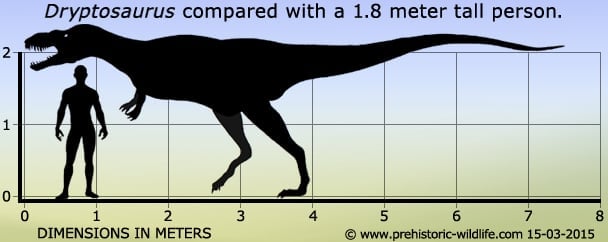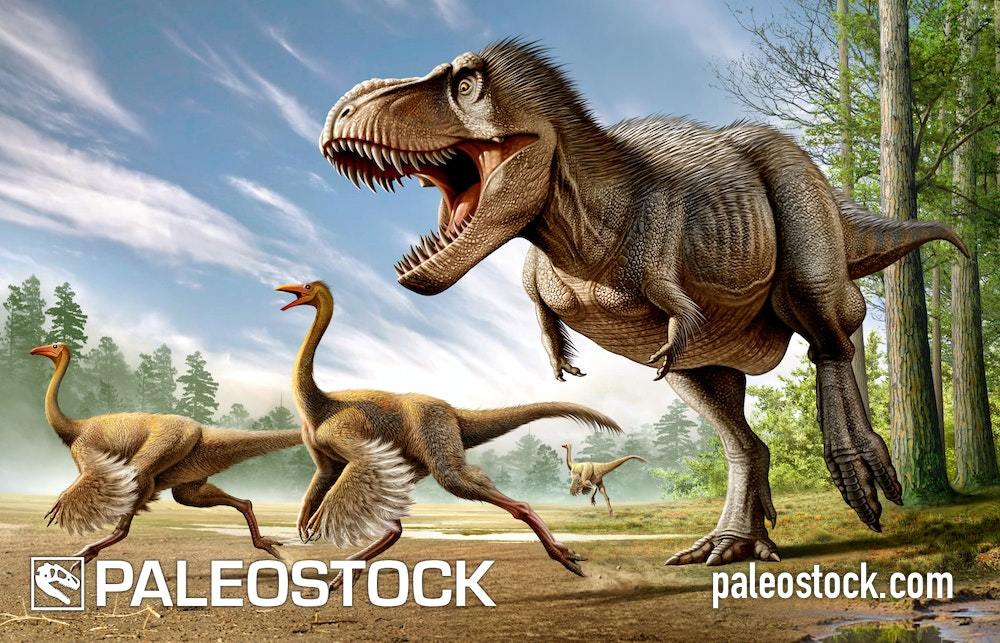There were pine trees, so the nuts are food, cycads are edible if the stuff is leached, ginkgos of course, likely acorns, and lots of ferns- but those are not all edible. But maybe some veggie seeds might be a good idea. Also an island with fresh water.
So you’d need a deep understanding of modern wild plant food foraging as a base of knowledge for analogizing, plus knowledge of how indigenous peoples prepare foods that are inedible or dangerous if not prepared properly but nutritious if done right. Like taro, for instance.
Who knows what in my microbiome might have wiped out whole species back then?
But keep in mind that this is only the dinosaurs in Laramidia, which is only the western half of North America. Appalachia, the other Campanian precursor to North America, was home to its own set of 10m+ tyrannosaurs, but they belonged to other genera rather than Tyrannosaurus.
Dryptosaurus is a famous large theropod from latest Cretaceous Appalachia.
Apparently many Appalachian critters retained basal traits that were lost in their Laramidian cousins, hence the Dryptosaurus’ third digit on the hand.
They were only 7 meters long, but we have a juvenile skeleton from a species we call Appalachiosaurus that was the same size and obviously not fully grown. So Appalachia almost certainly had rex sized tyrannosaurs of one type or another.
How many fossilized time travelers in that fossilized T-rex dung?
Fascinating. Thanks.
Well, I don’t want this to get into another firearms debate. This is beyond hypothetical anyway.
I think water would be quite readily available. But might kill a modern human. Shelter would be iffy, but probably doable. Probably unneeded I doubt you’ll freeze (I’m not going), but you will be miserable. A plastic tarp and about 100 feet of parachute cord might be nice.
You’re right about the stealthy toxicity of some fungi, but as a survival food, mushrooms are really rather poor nutrition - they can be tasty, which makes them valuable to the forager, but a whole kilo of fresh mushrooms contains about 250 calories.
They’re not, actually. Not in terms of calories.
More likely to taste like ostrich, IMO. Which tastes nothing like chicken, and quite a bit like aged beef or venison.
Perhaps the ostrich is the closest living relative to t-tex. Not genetically, i suppose all birds tie on that score. But it’s closer in size and form and function than most of the others who tie genetically.
I imagine that cooked dinosaur and cooked dinosaur eggs would be decent food sources. Maybe bring some vitamin C? Heck, bring multivitamins, who knows what vitamins life manufactured and used then.
The closest ostrich analogues would be the Ornithomimids, which includes Gallimimus of Jurassic Park fame and Struthiomimus which literally means “Ostrich Mimic”.
At the end of the dinosaur age in North America (or at least, Laramidia), you’d be looking at Ornithomimus itself:
Correct. Cycads are edible if properly processed. In fact one type of “arrowroot” is a type of florida Cycad, after much processing.
https://www.atlasobscura.com/articles/types-of-arrowroot#:~:text=Also%20called%20the%20coontie%20palm,starch%20produced%20in%20other%20regions.
During the late Civil war some starving CSA soldiers tried to eat cycads without properly processing. They got very sick, some died.
In some species the nuts are “edible”.
Maybe what you need to take with you are some food tasters; maybe a few dozen rats. Worst case scenario, you could just eat the rats.
There would be some safer bets than others in the late Cretaceous - true palms were emerging - and since there is a preponderance of edibility across the fruits of modern palm species (with exceptions that are somewhat amenable to simple testing - for example a lot of the inedible fruits of modern palms would taste inedibly bitter or sour), then if you found something that looks like a palm and has fruits like a date or a coconut, it would be probably a statistically safer thing to try eating than some other randomly-chosen fruit.
But it’s not a completely safe bet, because the cretaceous ancestors of (for example) palms might all have had some toxic property that has simply been lost in all modern descendants.
In animals, there are some general truisms that might still hold true back then - for example in insects, it is generally true that the ones that don’t hide, are more likely to be toxic than the ones that hide. If you see brightly coloured insect larvae boldly and conspicuously munching on leaves in broad daylight, there’s probably a reason they are resistant to predation; if you find dull-coloured insect larvae hiding away inside or under a rotting log, there’s a fair chance they’re hiding because they have no innate resistance to predation such as toxicity.
I think the most reliably edible sources of food would be bony fish, shellfish and crustaceans - seafood, basically. Also green and red algae should mostly be good to eat.
It’s not clear to me what in the water would make it dangerous to drink. What pathogens in water are not due to contamination by human feces?
Donno. Decades ago (I’m old but not 70 million years) me and my buddies would drink water from Rocky Mountain streams all the time. Things have changed though…
Parasites would probably be more likely. Don’t know how long Dracunculus (Guinea worms) have been around, but they don’t insist on having human hosts.
Parasites and pathogens are a two-edged sword. On the one hand, none of them have evolved against us, but on the other hand, we haven’t evolved against them, either. So what you’d see would be the general-purpose flexible pathogens vs. the general-purpose flexible human immune system. And biologists might know better than I, but I have no idea who would win that particular fight. I’m not sure I’d bet on the humans, though, because there are a lot of different flexible pathogens, and only one of them needs to win.

